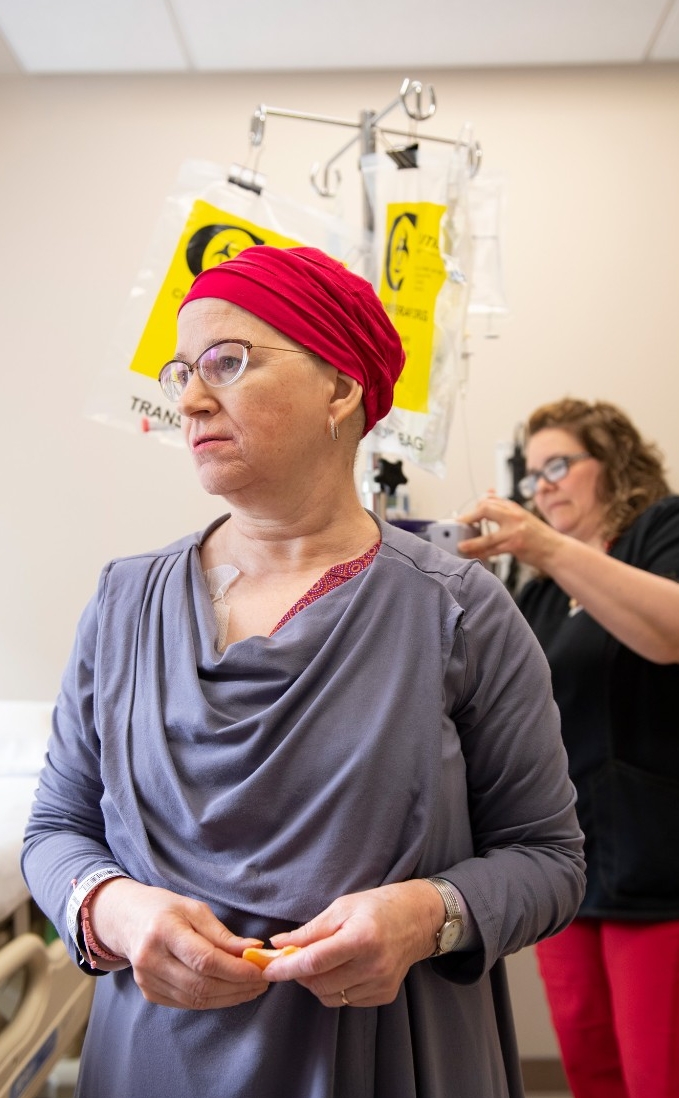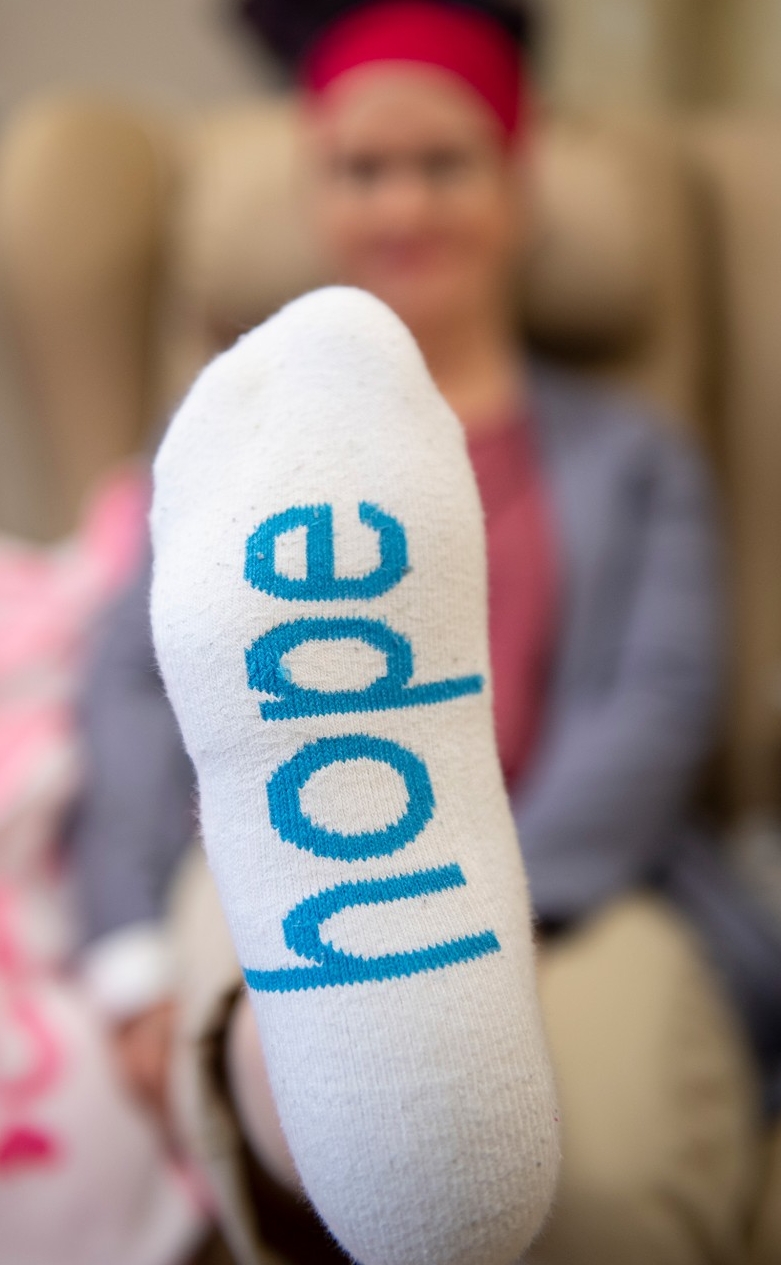UC breast cancer surgeon Beth Shaughnessy learns firsthand what it’s like to overcome cancer and keeps kindness and positivity at the center of her healing
By Katie Pence
Photography by Colleen Kelley
Photo illustration by Margaret Weiner
eth Shaughnessy is a modern-day Renaissance woman. She’s a musician as well as a scholar — an artist, a writer, a scientist, a professor, a doctor. She treats cancer patients as a surgical oncologist at the University of Cincinnati Medical Center.
But in January 2019, Shaughnessy became the breast cancer surgeon diagnosed with breast cancer herself.
“I found [it] doing a self-exam on Martin Luther King Day in 2019,” she says. She was alarmed, but, oddly, she wasn’t surprised.
“I always felt I was going to get breast cancer,” she says. “There’s a few things I sensed indefinitely and all came true. I was always going to look young, I was going to go gray early and I was going to get breast cancer. Look, it all happened.”
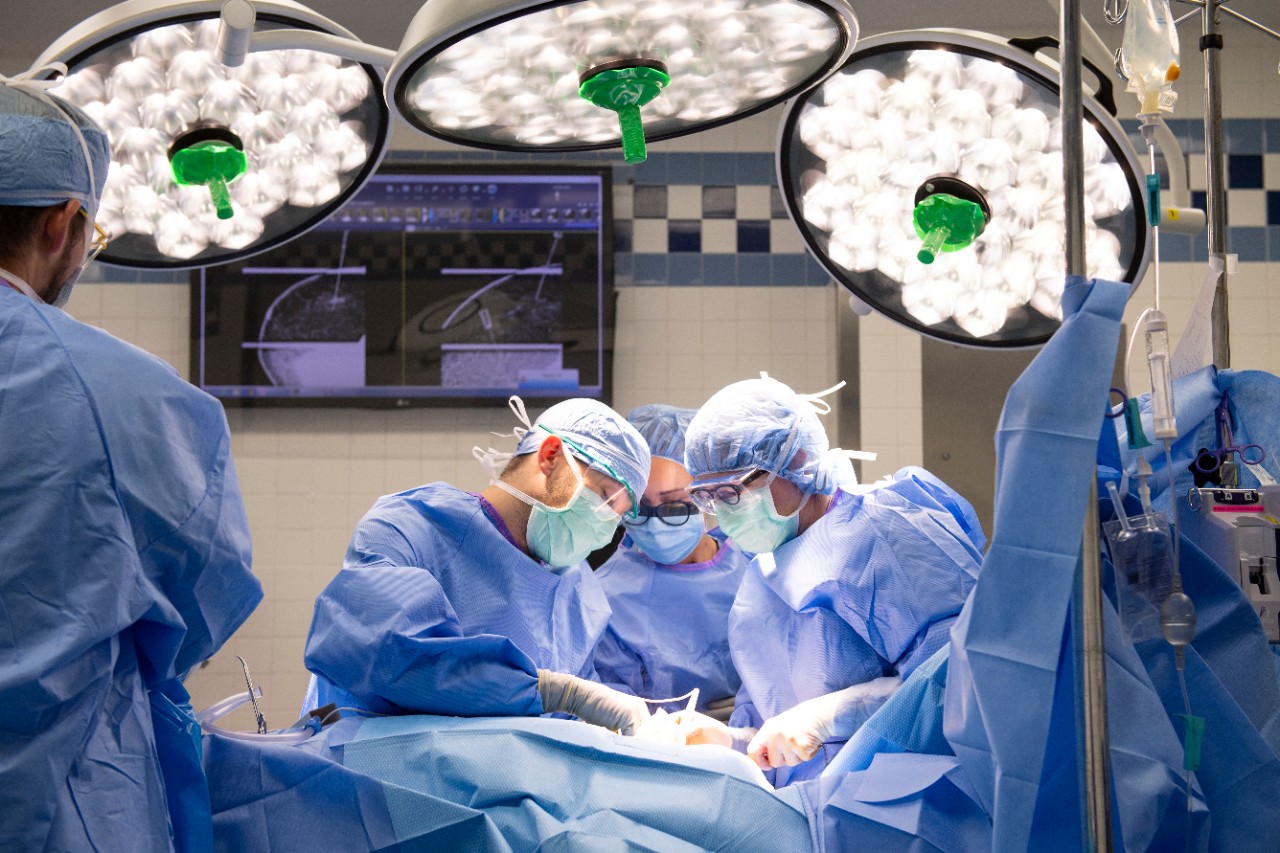
Beth Shaughnessy and a UC Medical Center resident conduct a breast surgery while a UC College of Medicine student observes.
Finding the path to her passion
Inversely, Shaughnessy didn’t always know she wanted to be a doctor, but she did have an inkling.
“My mother was an OR nurse who didn’t become a doctor because she couldn’t get through calculus, and my father was a mathematician who couldn’t finish his master’s degree because he couldn’t pass English,” she says, noting that she’s one of five kids in a large Irish Catholic family, the oldest in a bunch who grew up in Chicago and its suburbs.
Shaughnessy points out the framed medical sketches she completed when she was in medical school, now hanging in her office, where she has spent over 20 years of her career at UC. “I think I got a little of the right brain from my mom and the left brain from my dad. I’m fairly balanced,” she says.
She recalls the time her parents took her for an annual checkup in the fifth grade. “It’s already an awkward time in your life,” she remembers, “and then, the male doctor poked his head into the room and told me to strip — no gown, no mother with me. Also, we’re on the second floor of this medical building with huge windows overlooking one of the largest malls in Chicago. I didn’t change. The doctor came back very upset. He pointed at me and asked, ‘Why haven’t you changed? Do you know how busy I am? If you were in my shoes, you’d understand how disruptive this is.’
“I looked at him and said, ‘If I were in your shoes, I’d treat my patients better.’ And I started thinking, ‘Maybe I should be a doctor.’”
Medicine, art and law were all potential paths, but she eventually began a degree in architecture at the University of Illinois at Urbana-Champaign.
“I saw these students pulling all-nighters to finish a model, and I thought, ‘I’m only willing to spend that amount of time and effort if it’s going to help people,’” she says.
Shaughnessy became an honors biology major and was often the only girl in many of her classes. She paid her own way through school, undergrad and beyond, on her own merit, through grants, loans and scholarships. She was always working, whether it was making money for school or in the lab as a student.
Shaughnessy says she was undecided on research versus medical doctoring, but thanks to some persuading from her mentors, Benita Katzenellenbogen and Michael Walker, she decided to do it all. She earned her doctorate, medical degree and completed her residency at the University of Illinois at Chicago, where she got the first taste of her life’s work as part of a research group at a lab looking at estrogen receptors in the development of certain cancers and as a physician, finding the best course of treatment.
“As a resident, I was seeing that [my colleagues] didn’t know what to do if there wasn’t a clean cancer diagnosis for patients,” she remembers. “I was the one in the library, studying to find other options.”
She also met her husband — an architect, James Dennis Stapleton — in 1986 at a friend’s wedding.
They were married a year later.
“I never wanted to marry a guy who wanted to take care of me,” she adds, making note of her petite 5-foot frame. “You know, I was a little thing. And honestly, I’d been taking care of my family since middle school and doing so successfully. All of these people wanted to take care of me, and I was already taking care of myself. I always saw myself as a feminist. James just wanted to be my partner, and so, here we are, 32 years later.”
Shaughnessy completed her surgical oncology fellowship at the City of Hope National Medical Center in Duarte, California, in 1993, and then, after three years of pursuing postgraduate research, she started her career at UC in 1997, where she has been since.
She also had her son, a blessing, she says, since she also has polycystic ovarian syndrome (PCOS) and thought maybe she’d never have children. PCOS is a risk factor for breast cancer.
In addition to being a researcher, surgeon, wife, mom and general caregiver, she found the time to volunteer and reach out to the community. Shaughnessy got involved in the Susan G. Komen for the Cure, the largest and best-funded breast cancer organization in the United States. She also engaged with the Breast Cancer Registry of Greater Cincinnati, the largest registry of its kind in existence to date which was created the university by UC professor Susan Pinney. Shaughnessy is still involved in national organizations, like the Association of Women Surgeons, for which she was just named president-elect in October.
Yet, she still took time to hold her patient’s hands has they drifted to sleep before surgery, a practice in which she still participates.
“I don’t want them to be anxious or scared,” she says.
First-person view
As she showered in a hotel room in frigid Minneapolis — during a weekend in January she’d chosen to meet with colleagues at the University of Wisconsin to discuss a new technique for better operating on breast tumors — she felt the lump in the outer area of her left breast.
“I laid down after I first felt it – when your breast tissue is dense, you can feel masses better lying down,” she says. She felt it again. She cursed.
“I’d just turned 60 two weeks before,” she says. “I told everyone my warranty had expired.”
Shaughnessy immediately texted her nurse who moved up her screening mammogram, scheduled for the following week, and ordered a diagnostic workup.
“The next day, I was back to work but going between patients and getting my own imaging,” she says. “The mammogram showed nothing — it can happen with dense tissue — so I had an ultrasound. There they were: three additional suspicious masses, besides the one I felt.”
She had a biopsy and diagnosis by the end of the day and scheduled her surgery for the following week in order to complete her work up and to finish patient surgeries.
Surgery on Jan. 25 revealed more problems, including larger than expected tumors and merging of several of them. Additionally, several of her lymph nodes tested positive for cancer, and her tumors were found to have different “biologies,” meaning they required different treatments. The team prepared for a full double mastectomy.
“A mammogram did not detect any of this. That’s why self-exams are so important,” she says.
Shaughnessy selected two female surgeons to do her mastectomy on Feb. 8: fellow surgical oncologists at UC Dr. Jaime Lewis and Dr. Chantal Reyna.
“I think it was awkward for them to have to do this for their senior partner, but I felt I was in the best of hands, and I couldn’t just choose one of them, so I let each have a side,” she says.
Lewis says Shaughnessy was “the perfect patient.”
“She even arranged her own operating time, date and team,” she says. “One of the privileges that comes with working in academic medicine is caring for mentors and colleagues, those, like Beth, who make it their mission to pass along the wisdom and art of medicine. She has helped me shape my practice, and it was an honor to care for her.”
Lewis says at the request of Shaughnessy they created a playlist to listen to during the procedure.
“Her first request? ‘Pinch Me’ by Barenaked Ladies,” she says. “We also included ‘Pressure’ by David Bowie, quite appropo, ‘Fire’ by the Pointer Sisters, and I requested ‘Head Full of Doubt/Road Full of Promise’ by the Avett Brothers.
“When she was drifting to sleep, we held her hands and listened to Norah Jones.”
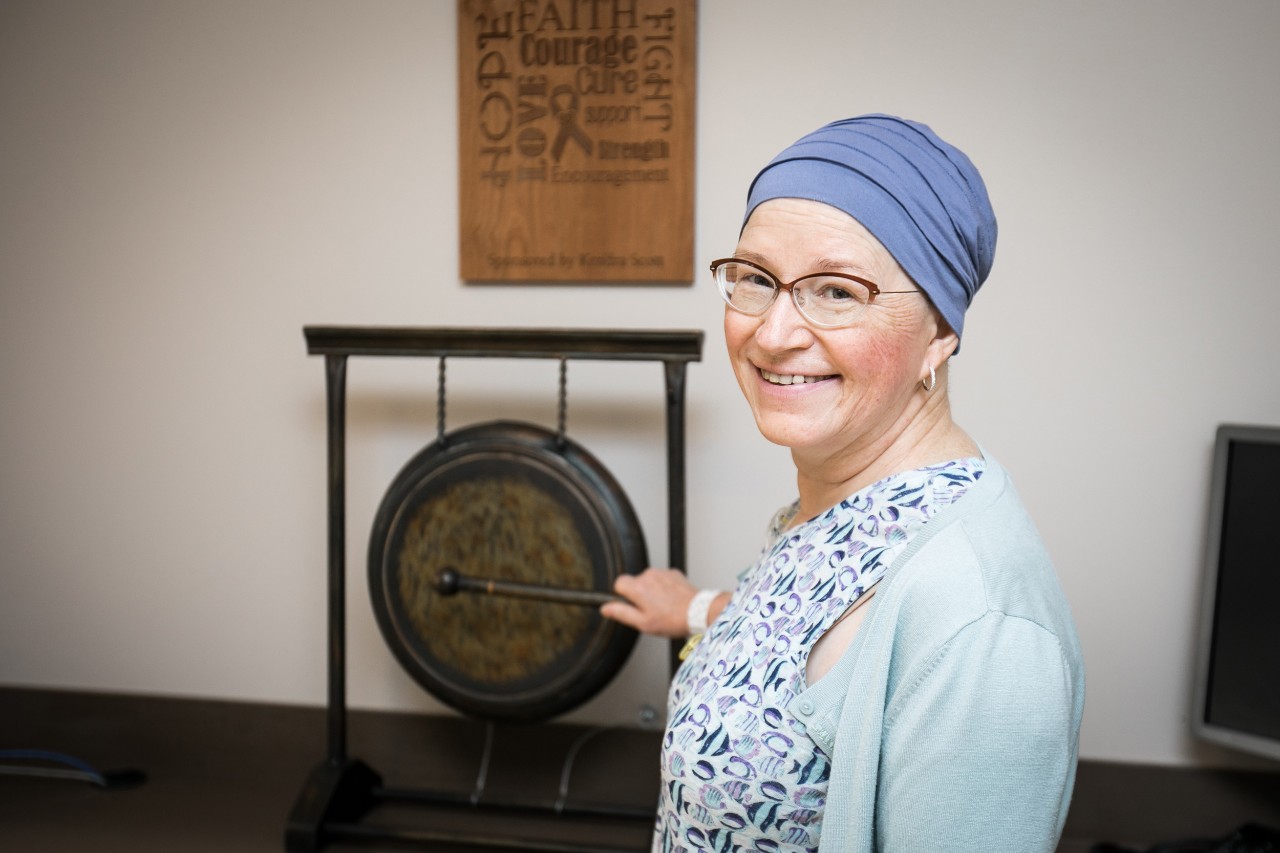
Shaughnessy hits the gong following her final chemotherapy treatment — a tradition at UC, signifying the end of treatment for patients with breast cancer.
Shaughnessy involved other UC colleagues for her treatment, undergoing chemotherapy under the watchful eye of UC Cancer Institute Breast Cancer Center Director Dr. Elyse Lower; radiation oncologist Dr. Teresa Meier oversaw her care at the UC Medical Center Proton Therapy Center. Surgeons Elizabeth Dale and Ryan Gobble will do her reconstruction surgery in summer 2020.
And throughout it all, Shaughnessy didn’t quit. She worked administratively, catching up on paperwork and submitting studies to scholarly journals. She just took lots of naps in between.
“The work doesn’t stop,” she says. “Deadlines don’t care if you have cancer. It kept my mind off of everything.”
She experienced many of the normal side effects — nausea and fatigue — and then lymphedema (swelling and fluid retention) of her chest wall and left arm, which she is still experiencing and managing.
“I have a one-hour program that helps relieve some of it, and then I have manual drainage,” she says, lifting up the sleeve of her arm and showing a compression cuff with a paisley design. She chooses designs to match her outfits and her stylish glasses. She even sports one with tattoos.
Shaughnessy is still experiencing some carpal tunnel syndrome in the wrists and mild, but improving, neuropathy in her hands and feet. But she takes it all in stride, and it’s not slowing her down.“It reminds me of the feeling I had with calluses on my fingers when I learned to play guitar,” she smiles. “It’s all OK when doing surgery though.”
She is back in the operating room and clinic, but still taking an immunotherapy treatment for her cancer.
“With my patients, I always tried to prepare them that the steps in their care plan might change,” she says. “Now, I totally understand what they were going through when that did happen. Since I always figured this would happen to me, I’d already created my own algorithm to treatment, but I had so many surprises along the way. I was in let’s-get-this-done mode, and here I am. You don’t realize how many people it takes to help you get through this – the physical and emotional support required, from members of my family to members of my church to members of my yoga class.
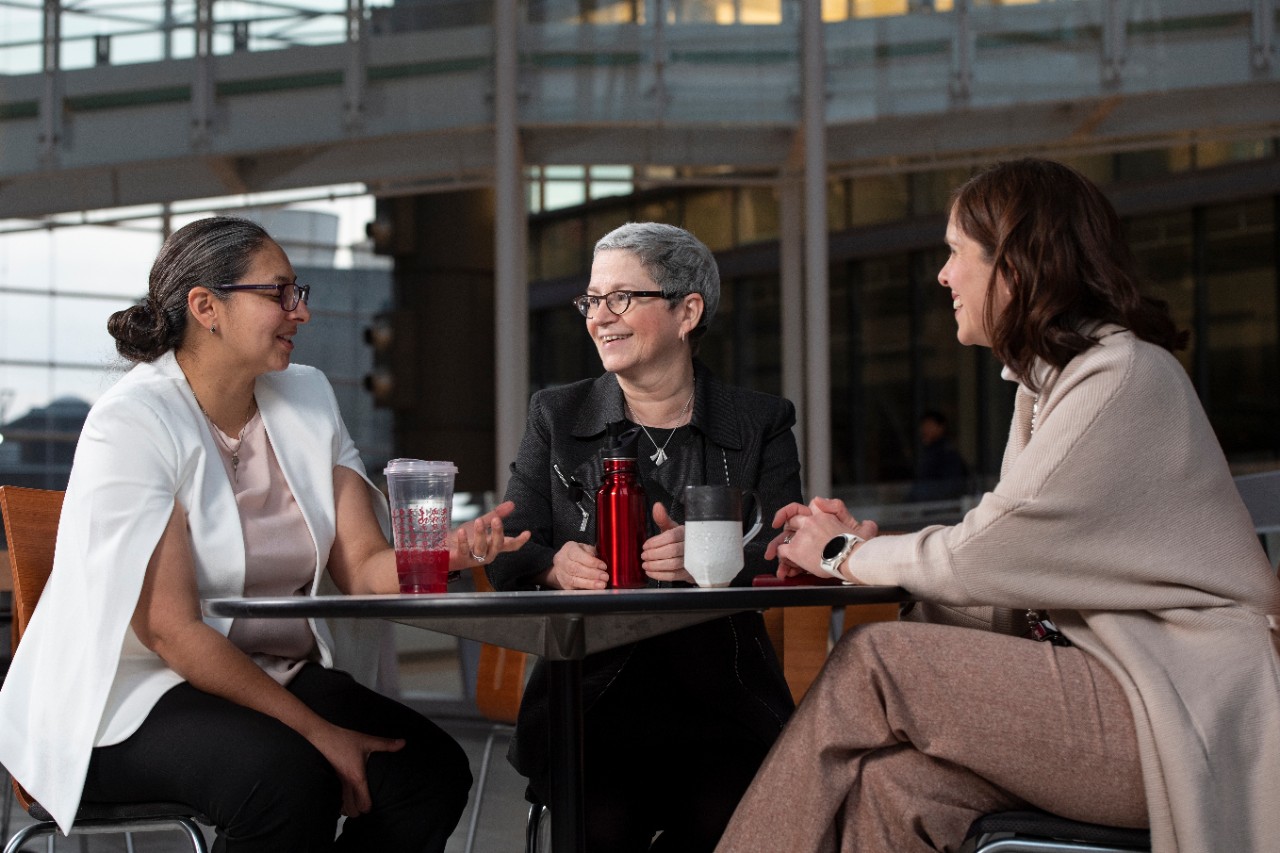
Surgical oncologists Chantal Reyna (left) and Jaime Lewis (right) both operated on Shaughnessy. Lewis, who is Shaughnessy’s mentee, says that she was the “perfect patient.”
“Throughout the years, and in all of my experiences, I always chose my battles carefully; people questioned if I could stand up for myself because I am ‘nice.’ I can speak up when necessary. I just know when it’s time to fight.”
Support breast cancer research at UC by donating to the Marlene Harris-Ride Cincinnati Fund at ridecincinnati.org. Schedule a mammogram or find a UC Health physician at 513-584-PINK (7465) or uchealth.com.
FEATURE STORIES
Hope after hate
UC professor and Emmy-award winning journalist shares her father’s Holocaust survival story with lessons to inspire action against hatred and bigotry today.
Good neighbors - better partners
UC, Cincinnati Public Schools work together to create something special at a new school.
Role reversal
UC breast cancer surgeon Beth Shaughnessy learns firsthand what it’s like to overcome cancer and keeps kindness and positivity at the center of her healing
Traffic of tomorrow
More driverless cars. More networked roads. More naps. UC is helping change how we drive.
